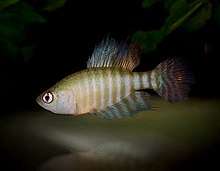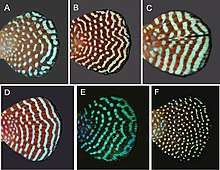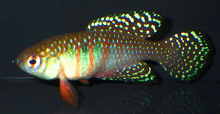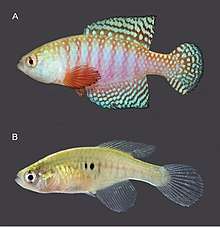Hypsolebias
Hypsolebias is a genus of small fish in the family Rivulidae that are endemic the Caatinga, Cerrado and nearby regions in Brazil. The greatest richness is in the São Francisco River basin, but there are also species in the Tocantins, Jequitinhonha and Jaguaribe systems, as well as smaller river basins in northeastern Brazil.[2][3] Like their relatives, Hypsolebias are annual killifish.[4] The short-lived adults inhabit temporary waters like rain pools, laying their eggs in the bottom. As their habitat dries up the adults die, but the eggs survive and hatch when the water returns in the next season.[2]
| Hypsolebias | |
|---|---|
 | |
| Hypsolebias brunoi | |
| Scientific classification | |
| Kingdom: | Animalia |
| Phylum: | Chordata |
| Class: | Actinopterygii |
| Order: | Cyprinodontiformes |
| Family: | Rivulidae |
| Genus: | Hypsolebias W. J. E. M. Costa, 2006 |
| Type species | |
| Cynolebias flavicaudatus W. J. E. M. Costa & G. C. Brasil 1990[1] | |
The males are more colorful than the females, and male colors/patterns are a primary way of separating the different species.[2] They are small fish that reach up to 7 cm (2.8 in) in total length.[5]
Species




Hypsolebias was formerly regarded as a subgenus of Simpsonichthys.[2][6] Although this split is generally accepted, a genetic study indicates that Hypsolebias is not monophyletic.[7]
There are 35 currently recognized species in Hypsolebias:[5]
- Hypsolebias adornatus (W. J. E. M. Costa, 2000)
- Hypsolebias antenori (Tulipano, 1973)
- Hypsolebias auratus (W. J. E. M. Costa & D. T. B. Nielsen, 2000)
- Hypsolebias brunoi (W. J. E. M. Costa, 2003)
- Hypsolebias caeruleus W. J. E. M. Costa, 2013[8]
- Hypsolebias carlettoi (W. J. E. M. Costa & D. T. B. Nielsen, 2004)
- Hypsolebias coamazonicus W. J. E. M. Costa, Amorim & Bragança, 2014[3]
- Hypsolebias faouri Britzke, D. T. B. Nielsen & C. de Oliveira, 2016[2]
- Hypsolebias flagellatus (W. J. E. M. Costa, 2003)
- Hypsolebias flammeus (W. J. E. M. Costa, 1989)
- Hypsolebias flavicaudatus (W. J. E. M. Costa & G. C. Brasil, 1990)
- Hypsolebias fulminantis (W. J. E. M. Costa & G. C. Brasil, 1993)
- Hypsolebias ghisolfii (W. J. E. M. Costa, Cyrino & D. T. B. Nielsen, 1996)
- Hypsolebias gilbertobrasili W. J. E. M. Costa, 2012[9]
- Hypsolebias guanambi W. J. E. M. Costa & Amorim, 2011
- Hypsolebias harmonicus (W. J. E. M. Costa, 2010)
- Hypsolebias hellneri (Berkenkamp, 1993)
- Hypsolebias igneus (W. J. E. M. Costa, 2000)
- Hypsolebias janaubensis (W. J. E. M. Costa, 2006)
- Hypsolebias longignatus (W. J. E. M. Costa, 2008)
- Hypsolebias lopesi (D. T. B. Nielsen, Shibatta, Suzart & A. F. Martín, 2010)
- Hypsolebias macaubensis (W. J. E. M. Costa & Suzart, 2006)
- Hypsolebias magnificus (W. J. E. M. Costa & G. C. Brasil, 1991)
- Hypsolebias martinsi Britzke, D. T. B. Nielsen & C. de Oliveira, 2016[2]
- Hypsolebias mediopapillatus (W. J. E. M. Costa, 2006)
- Hypsolebias nitens W. J. E. M. Costa, 2012[9]
- Hypsolebias notatus (W. J. E. M. Costa, Lacerda & G. C. Brasil, 1990)
- Hypsolebias nudiorbitatus W. J. E. M. Costa, 2011[10]
- Hypsolebias picturatus (W. J. E. M. Costa, 2000)
- Hypsolebias pterophyllus W. J. E. M. Costa, 2012[9]
- Hypsolebias radiosus (W. J. E. M. Costa & G. C. Brasil, 2004)
- Hypsolebias radiseriatus W. J. E. M. Costa, 2012[9]
- Hypsolebias sertanejo W. J. E. M. Costa, 2012[9]
- Hypsolebias shibattai D. T. B. Nielsen, M. Martins, L. M. de Araújo & Suzart, 2014[11]
- Hypsolebias tocantinensis D. T. B. Nielsen, J. C. da Cruz & A. C. Baptista, 2012[12]
- Hypsolebias trifasciatus D. T. B. Nielsen, M. Martins, L. M. de Araújo, F. O. de Lira & A. F. Martín, 2014[13]
References
- Eschmeyer, W. N.; R. Fricke & R. van der Laan (eds.). "genid=10903". Catalog of Fishes. California Academy of Sciences. Retrieved 12 September 2019.
- Britzke, R., Nielsen, D.T.B. & Oliveira, C. (2016): Description of two new species of annual fishes of the Hypsolebias antenori species group (Cyprinodontiformes: Rivulidae), from Northeast Brazil. Zootaxa, 4114 (2): 123–138.
- Costa, W.J.E.M., Amorim, P.F. & Bragança, P.H.N. (2014): Species limits and phylogenetic relationships of red-finned cryptic species of the seasonal killifish genus Hypsolebias from the Brazilian semi-arid Caatinga (Teleostei: Cyprinodontiformes: Rivulidae). Journal of Zoological Systematics and Evolutionary Research, 52 (1): 52-58.
- Berois, N.; G. García; R.O. de Sá, eds. (2015). Annual Fishes: Life History Strategy, Diversity, and Evolution. CRC Press. pp. 24–25. ISBN 9781482299717.
- Froese, Rainer and Pauly, Daniel, eds. (2018). Species of Hypsolebias in FishBase. November 2018 version.
- Costa, W.J.E.M. (2010). "Historical biogeography of cynolebiasine annual killifishes inferred from dispersal–vicariance analysis". Journal of Biogeography. 37 (10). doi:10.1111/j.1365-2699.2010.02339.x.
- Ponzetto, J.M.; R. Britzke; D.T.B. Nielsen; P.P. Parise-Maltempi; A.L. Alves (2016). "Phylogenetic relationships of Simpsonichthys subgenera (Cyprinodontiformes, Rivulidae), including a proposal for a new genus". Zoologica Scripta. 45 (4). doi:10.1111/zsc.12159.
- Costa, W.J.E.M. (2013): Hypsolebias caeruleus, a new seasonal killifish of the Hypsolebias adornatus complex from the Caatinga of north-eastern Brazil, São Francisco River basin (Cyprinodontiformes: Rivulidae). Ichthyological Exploration of Freshwaters, 24 (2): 141-146.
- Costa, W.J.E.M., Amorim, P.F. & Mattos, J.L.O. (2012): Species delimitation in annual killifishes from the Brazilian Caatinga, the Hypsolebias flavicaudatus complex (Cypriniformes: Rivulidae): implications for taxonomy and conservation. Systematics and Biodiversity, 10 (1): 71-91.
- Costa, W.J.E.M. (2011): Hypsolebias nudiorbitatus, a new seasonal killifish from the Caatinga of northeastern Brazil, Itapicuru River basin (Cyprinodontiformes: Rivulidae). Ichthyological Exploration of Freshwaters, 22 (3): 221-226.
- Nielsen, D.T.B., Martins, M., Araujo, L.M.d. & Suzart, R.d.R. (2014): Hypsolebias shibattai, a new species of annual fish (Cyprinodontiformes: Rivulidae) from the rio São Francisco basin, northeastern Brazil. aqua, International Journal of Ichthyology, 20 (1): 27-34.
- Nielsen, D.T.B., Cruz, J.C. & Baptista, A.C.Jr. (2012): A new species of annual fish, Hypsolebias tocantinensis sp.n. (Cyprinodontiformes:Rivulidae) from the rio Tocantins basin, northeastern Brazil. Zootaxa, 3527: 63–71.
- Nielsen, D.T.B., Martins, M., Araujo, L.M.d., Lira, F.O.d. & Faour, A. (2014): Hypsolebias trifasciatus, a new species of annual fish (Cyprinodontiformes: Rivulidae) from the rio Preto, rio São Francisco basin, northeastern Brazil. aqua, International Journal of Ichthyology, 20 (3): 131-138.